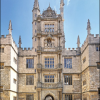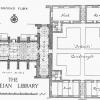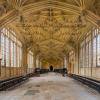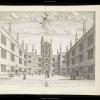The Schools Quadrangle, 1613-24
External links
Commentary
Image 1. Schools Quadrangle in the present day, taken from within.
Image 2. Schematic representation of the typical late medieval and early modern university curriculum. Credits: Nermeen Hilton (third-year student, Balliol College, Oxford, February 2018).
Images 3-7. Schools Quadrangle, Bodleian Library, 1613-24. 3: Plan of the Quadrangle, indicating the location of the individual 'schools' 4: west facade: entrance to the Divinity School. 5: north facade: exit toward Clarendon Building, Sheldonian Theatre, Old Ashmolean, Broad Street. 6: east facade: Tower of the Five Orders, exit toward Catte Street. 7: south facade, exit toward Radcliffe Square. Source: all images from panoramic view.
Image 2. From the late medieval period well into the seventeenth century, universities across Europe adopted a more or less uniform curriculum. At its pinnacle were one or more of the three higher faculties: theology, law and medicine. Below these was the fourth faculty, designated as ‘arts’ or ‘philosophy’, which was regarded as propaedeutic (that is, preparatory) to the study of the higher disciplines. As its ambiguous names suggest, this fourth faculty was divided between the three philosophies and the seven liberal arts, which were further divided into the trivium and the quadrivium.
Image 3. Nowhere is the resilience of this curriculum more palpably manifest that in the Schools Quadrangle of Oxford University, built between 1613 and 1624. Within the quadrangle, every one of these disciplines is inscribed over a doorway to one of the ‘schools’ as the chambers set aside for lectures and disputations in the named disciplines were called. The three higher faculties and the three philosophies all have ‘schools’ of their own. The quadrivium occupies three schools rather than four, because arithmetic and geometry are housed together. The trivium, on the other hand, occupies four schools rather than three, because separate housing is provided for Latin and Greek grammar. Only one discipline is listed which is not in this age-old scheme: history, which shares a school with grammar.
These slight anomalies are all suggestive of the intellectual values of Oxford and many other European universities during the early seventeenth century.
Expansion of the trivium. During the sixteenth century, Renaissance humanism had vastly increased the emphasis placed on a thorough mastery of Greek as well as Latin grammar, and the Biblicism of the Reformation had enhanced the emphasis on Hebrew. As a consequence, grammar effectively outgrew a single lecture room within the Schools Quadrangle and was assigned two: one for Greek and Hebrew and a second for Latin. Yet humanism also focused unprecedented academic attention on history, which was squeezed into the same lecture room as Latin grammar.
Constriction of the quadrivium. These additions to the trivium were accommodated, in effect, by reducing the space devoted to the quadrivium. While the 'superior' mathematical disciplines of music and astronomy maintained schools of their own, the two 'inferior' mathematical disciplines, arithmetic and geometry, were forced to share. Alone of the quadrivial subjects, music was demoted to the ground floor: the Laudian statutes stipulated a termly music lecture in comparison with bi-weekly lectures in the other quadrivium subjects, so this must have been the least frequented school in the quadrangle. These compromises are indiciative of the relatively marginal place of the quadrivium within the structure of received learning founded. Quantitative methods were marginal to Aristotle's conception of scientific knowledge, and of little use for higher study in law or theology. The primary utility of mathematics within the established curriculum was in providing the astrological element of contemporary medical practice. Outside the university, however, the enormous practical utility of mathematics was rapidly becoming apparent; and its theoretical utility to natural philosophy would become dramatically apparent during the course of the seventeenth century.
The three philosophies and the three higher disciplines. The most elegant aspect of this arrangement, however, is the placement of the three philosophies and the three higher disciplines. Theology, is placed opposite the main entrance to the quadrangle, locating it as the ultimate destination of learning: a doctorate in Divinity took eleven years to achieve, versus only seven for Law and Medicine. The incomparable grandeur of the Divinity School likewise marks it out as the highest of the higher faculties. The other higher faculties flank it on either side: medicine to the left, law on the right. This arrangement is partly practical: the southerly orientation of the Schola Medicinae benefits from the better natural illumination needed for anatomical dissections. But it may also beintended to indicate the superiority of law (which governs the collective body politic) to medicine (which heals the individual physical body). Both law and medicine are elevated to the first floor of the quadrangle, and these two disciplines alone have staircases of their own, preventing advanced students from mingling with their juniors. Below them are the philosophies which provide preparation for higher study: natural philosophy is most indispensible for medicine, moral philosophy for law. The third philosophy, metaphysics, cannot be located under the Divinity School, and is less satisfactorily placed at the opposite side of the quadrangle.
Credits: Nermeen Hilton (Image 2) and Howard Hotson (February 2018)




